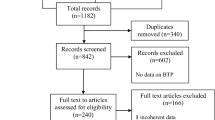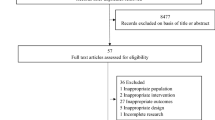Abstract
Introduction and hypothesis
In this systematic review we aimed to assess if the Epi-No birth trainer used during antepartum could prevent perineal trauma in nulliparous women.
Methods
We searched CENTRAL, MEDLINE, EMBASE, Scielo, and Conference abstracts, looking for randomized controlled studies (RCT). High heterogeneity (i2 > 50 %) was corrected with random models. All studies were analyzed according to their quality and risk of bias. Nulliparous women or women whose previous pregnancy ended before 21 weeks’ gestation were included and the main outcome measures were: episiotomy rates, perineal tears, severe (3rd/4th) perineal tears, and intact perineum.
Results
Five studies were included (1,369 participants) for systematic review and two of them (932 participants) were eligible for meta-analysis. Epi-No did not reduce episiotomy rates (RR 0.92 [95%CI 0.75–1.13], n = 710, p =0.44; two studies; fixed model) and second stage of labor (MD −12.50 [95%CI −29.62, –4.62], n = 162, p = 0.54; one study; fixed model), and did not increase intact perineum (RR 1.15 [95 % CI 0.81–1.64], n = 705, p = 0.43; two studies; random model). No influence of Epi-No on reducing all perineal tears (RR 0.99 [95%CI 0.84–1.17], n = 705, p = 0.93, two studies; fixed model) or severe (3rd/4th) perineal tears (RR 1.31 [95%CI 0.72–2.37], n = 705, p = 0.38, two studies; fixed model). Mean birthweight of the Epi-No group was higher than that of the control group in both studies, with no statistical significance.
Conclusion
Epi-No birth trainer is a device that did not reduce episiotomy rates and had no influence on reducing perineal tears.










Similar content being viewed by others
References
Oliveira LS, Brito LG, Quintana SM, Duarte G, Marcolin AC (2014) Perineal trauma after vaginal delivery in healthy pregnant women. Sao Paulo Med J 132(4):227–234
Borrelo-France D, Burgio KL, Richter HE et al (2006) Fecal and urinary incontinence in primiparous women. Obstet Gynecol 108(4):863–872
Carroli G, Mignini L (2009) Episiotomy for vaginal birth. Cochrane Database Syst Rev 1:CD000081
Christianson LM, Bovberg VE, McDavitt EC, Hullfish KL (2003) Risk factors for perineal injury during delivery. Am J Obstet Gynecol 189:255–260
Krause HG, Natukunda H, Singasi I, Hicks SS, Goh JT (2014) Treatment-seeking behaviour and social status of women with pelvic organ prolapse, 4th-degree obstetric tears, and obstetric fistula in western Uganda. Int Urogynecol J 25(11):1555–1559 doi:10.1007/s00192-014-2442-6
Beckmann MM, Stock OM (2013) Antenatal perineal massage for reducing perineal trauma. Cochrane Database Syst Rev 4:CD005123
Assheim V, Nilsen AB, Lukasse M, Reinar LM (2011) Perineal techniques during the second stage of labour for reducing perineal trauma. Cochrane Database Syst Rev 12:CD006672
Hillebrenner J, Wagenpfeil S, Schuchardt R, Schelling M, Schneider KT (2001) Initial experiences with primiparous women using a new kind of Epi-no labor trainer. Z Geburtshilfe Neonatol 205(1):12–19
Moher C, Liberati A, Tetzlaff J, Altman DG (2009) Preferred reporting items for systematic reviews and meta-analyses: the PRISMA statement. BMJ 339:b2535
Ruckhaberle E, Jundt K, Bauerle M et al (2009) Prospective randomized multicenter trial with the birth trainer EPI-NO for the prevention of perineal trauma. ANZOG 49:478–483
Shek KL, Chantarasorn V, Langer S, Phipps H, Dietz HP (2011) Does the Epi-No birth trainer reduce levator trauma? A randomized controlled trial. Int Urogynecol J 22:1521–1528
Dietz HP, Langer S, Kamisan Atan I, Shek KL, Caudwell-Hall J, Guzman Rojas R (2014) Does the Epi-No prevent pelvic floor trauma? A multicentre randomised controlled trial. ICS Abstracts. Available at: http://www.ics.org/Abstracts/Publish/218/000394.pdf
Kok J, Tan KH, Koh S et al (2004) Antenatal use of a novel vaginal birth training device by term primiparous women in Singapore. Singap Med J 45(7):318–323
Kovacs GT, Health P, Healther C (2004) First Australian trial of the birth-training device Epi-No: a highly significantly increased chance of an intact perineum. ANZJOG 44:347–348
Higgins JPT, Altman DG, Sterne JAC (2011) Chapter 8: assessing risk of bias in included studies. In: Higgins JPT, Green S (eds) Cochrane Handbook for Systematic Reviews of Interventions Version 5.1.0 (updated March 2011). The Cochrane Collaboration. Available from www.cochrane-handbook.org
Nakamura MU, Sass N, Elito Junior J et al (2014) Parturient perineal distensibility tolerance assessed by EPI-No: an observational study. Einstein 12(1):22–26
Kubotani JS, Moron AF, Araujo-Junior E, Zanetti MR, Soares VC, Elito-Junior J (2014) Perineal distensibility using Epi-No in twin pregnancies: comparative study with singleton pregnancies. ISRN Obstet Gynecol 2014:124206. doi:10.1155/2014/124206
Edozien L, Gurol-Urganci I, Cromwell D et al (2014) Impact of third- and fourth-degree perineal tears at first birth on subsequent pregnancy outcomes: a cohort study. BJOG 121(13):1695–1703. doi:10.1111/1471-0528.12886
Pergialiotis V, Vlachos D, Protopapas A, Pappa K, Vlachos G (2014) Risk factors for severe perineal lacerations during childbirth. Int J Gynaecol Obstet 125(1):6–14
Manzanares S, Cobo D, Moreno-Martinez MD, Sanchez-Gila M, Pineda A (2013) Risk of episiotomy and perineal lacerations recurring after first delivery. Birth 40(4):307–311
Higgins JP, Thompson SG, Deeks JJ, Altman DG (2003) Measuring inconsistency in meta-analyses. BMJ 327(7414):557–560
Acknowledgements
We would like to thank Nieck Pouwels for helping us with the German translation of the Hillebrenner data.
Conflicts of interest
None.
Authors’ participation
L.G. Brito: project development, data collection/analysis, manuscript writing/editing; A.C. Marcolin: project development, data collection, manuscript editing; C.H. Ferreira: manuscript writing/editing; G. Duarte, and A.A. Nogueira: project development, manuscript editing
Funding
The authors declare that no funding was provided to perform this systematic review.
Author information
Authors and Affiliations
Corresponding author
Rights and permissions
About this article
Cite this article
Brito, L.G.O., Ferreira, C.H.J., Duarte, G. et al. Antepartum use of Epi-No birth trainer for preventing perineal trauma: systematic review. Int Urogynecol J 26, 1429–1436 (2015). https://doi.org/10.1007/s00192-015-2687-8
Received:
Accepted:
Published:
Issue Date:
DOI: https://doi.org/10.1007/s00192-015-2687-8




